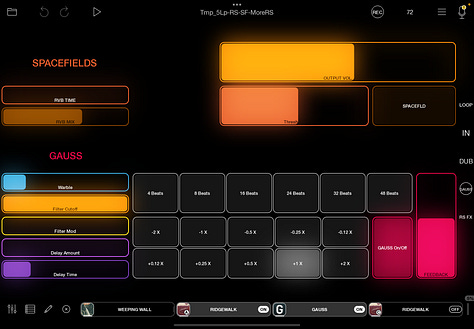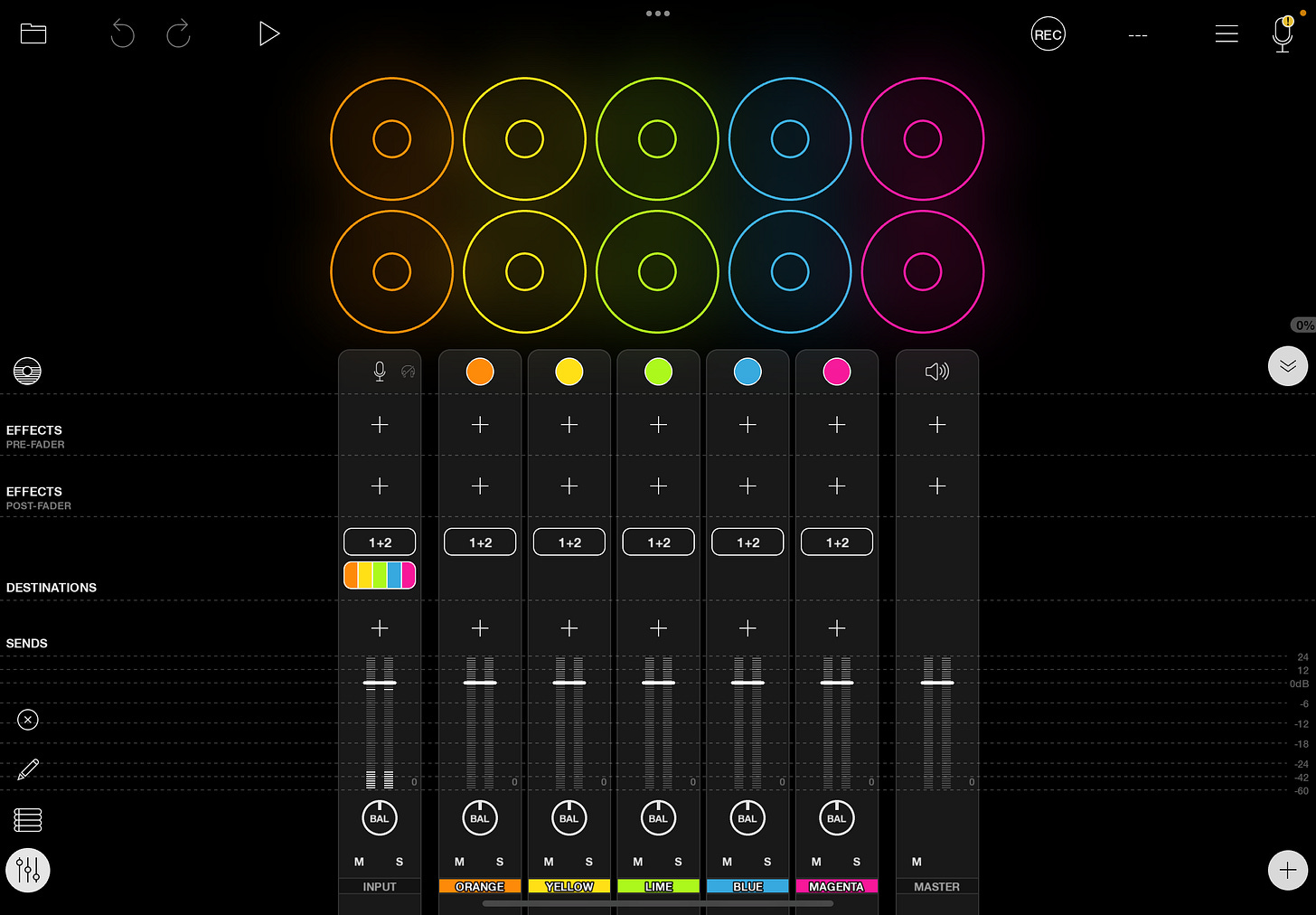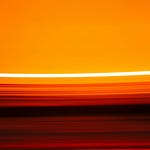Tricky question, I know !
But I don’t find any other way to characterize this new improvisation….
It’s in a major key (a pretty rare occurrence) and was recorded with lapsteel & resonator guitar + voice. It starts with a slow wandering melodic build-up played with a very dry lapsteel tone (another rare occurrence) that gives a very earthy & warmshinningsunny feeling, until the (almost) “Sigur Rós moment” when the string section (Which is actually emulated here by bowing the lapsteel strings with a file) enters & makes it all majestic…
It doesn’t last very long before dissolving into a textural soundscape… I wish I had kept it going a bit longer.
I had no intention to use my small brass body resonator, but it was on the couch nearby so I grabbed it and used the microphone that was set for my voice to add a bit of it at the end, which revealed to be quite a nice way to go back to the earthy feeling we started with.
I hope you’ll dig this 18 min ride, and that it allows you to catch your breath and gather some strength to disrupt the disruption to come…
My Live-Looping Rig:
Ever since I’ve been making music with loopers, I’ve used many different rigs.
Because software loopers have usually been more capable than hardware ones (see my previous post for explanations), my main rig has been based on a laptop with software loopers, with the addition of MIDI/USB physical controllers. It’s been a very versatile & quite portable solution but it requires to reprogram the controllers each time I make changes to the software side of it, which can be very time consuming.
After a decade using this laptop rig, I explored Eurorack Modular systems & used some of the most creative loopers out there. I released records with small minimalist setups & one with a big system that felt like driving the Titanic.
Modular systems are amazing in terms of creativity & explorations but are very demanding time wise, on top of not being practical at all (I will make a post about what I learned from & why I left the modular world at some point).
Just when I decided to leave the modular world, pretty much at the same time, 2 new looper pedals were released: The SOMA Cosmos & The Glou-Glou Loupé. Together, they looked like my looping wet dream coming true. I got them both & recorded the Synaesthetic Explorations with them.
Both loopers did some things very very well and both had their drawbacks:
The Glou-Glou Loupé is very creative & put the power in the hand of the user. Not only it features functions I’ve always wanted to have, it also had new unique capabilities. I was able to do rhythmic & glitchy stuff very easily & transform the loops in incredible ways. Sadly the lack of MIDI implementation made it cumbersome to synchronize to external devices. I also had issues with the click of the footswitches that let themselves be heard, recorded and looped when I was using a microphone for my voice.
The SOMA Cosmos is more of a tape-emulating looper with granular possibilities. It’s conceived as an “anti-looper”, which means it does a lot of pseudo-random stuff that the user can not fully control. This was a big problem for me, on top of some design choices that made creating a flowing live performance hard, if you don’t want it to be very repetitive. The pseudo-random aspect makes the device feel like there’s magic in it, especially if you have only used basic loopers. Me, I just felt stuck & ended up using it mainly for textures and accompaniment while the Loupé was leading the performances.
Meanwhile, a very interesting iOS app called Loopy Pro was launched, and I casually started to experiment with it on my old iPad. A big community formed around it and the developer (a single person called Michael Tyson) kept improving it based on the users feedback.
Meanwhile, I was also involved in the Koala Creative Community, a beatmaker community based around a SP404-like sampler app called Koala Sampler. My iPad was struggling when I was doing complex things with it… Loopy Pro was getting better & better (for example: the feedback setting function I talked about in the previous post was implemented at some point) and I grew tired with dealing with the setup time that hardware loopers required. So I sold both the Cosmos & Loupé & bought a newer, second hand iPad.
Enters Loopy Pro !
More than a simple & single looper, Loopy Pro (let’s call it LP from now on) is a workstation based around looping or a live-looping ecosystem if you will (an echo-system maybe ?)
Not only you can have as many loopers as the power of your iPad allows, but these loopers can interact with each other, you can had effects to your inputs, before & after the loopers. You have a mixer page to balance every aspects of your audio & a multitrack recorder to record each track separately and flawlessly so you can export your live recordings to edit and mix later.
It also features a lot of controllers (buttons, dials, faders, grids, etc..) so you can control pretty much every aspects of it… It is incredibly convenient compared to using external controllers as I did with the laptop based rig. And way easier to carry around because the laptop + 1 or 2 controllers + all the cables are replaced by a book-sized device.
I almost forgot to mention that LP can host iOS instruments as well (Koala sampler for example) & that there are a lot of talented independent developers making super creative stuff for iOS… I’d very much like to see this kind of thriving ecosystem & community in the open source world so we don’t have to depend on a multinational company… You may say I’m a dreamer but I have good reasons to think I’m not the only one…
With great power come great complexity…
The more options you have the more time it takes to explore the possibilities & decide what to do… With LP this process took me more than a year, and it’s only since the end of August 2024 that I have started working at developing my own template.
This is the most recent version of the setup I’ve used to record the new tracks & several others to come.






As you can see, it’s really over the top but, since it’s not possible to copy/paste part of a template in another one (yet!), I had no other choice than developing a giant template that “does everything”, and test it on several improvisations to fine tune it. This is how I record the tracks I’m sharing now.
Of course, it makes for very dense music but my goal in the future is to use only parts of this template depending on what I want to focus on. It’s quite fascinating how different configurations can lead to vastly different results, and I definitely want to experiment with simpler rigs.
You can’t always get what you want, but if you try sometimes…
There were a couple of things in my previous looping rig (Glou-Glou Loupé + Soma Cosmos) that became indispensable to me, and I had to be sure to be able to find a way to get LP to do them before making it my main rig.
The “replace” function:
I mentioned it in my previous newsletter, the “replace” function allows to instantly replace (duh!) whatever is already recorded in the loop with what you’re currently playing. I use it a lot to create rhythms, glitchy loops or create arpeggios from long notes. It’s an amazing tools to slowly turn a loop into something else.
There’s no “replace” function currently in LP but it was easy to create one thanks to the control buttons that can send many different messages to any parameters. I just had to program a button to “tell” the looper to set its feedback to 0 + record at the same: done !
How Loupé can record every changes & print it in the loop:
As long as “record” is enabled, Loupé is recording everything that’s happening to the loop: Whether you’d pitch the loop up or down for a second, reverse it and so on, those “movements” would be printed in the loop. This is another great way to transform loops.
The thing is Loupé is actually made of 2 loopers that are constantly recording back and forth into in each other. This is what I tried to reproduce in LP, and this was not easy at all!
I had to setup a “resampling” track that hosts a bunch of effects & its very own looper so I can record & loop what I chose to send to it. I then can have one of the main loopers going through it & change any parameters of the loop (pitch up or down, reverse, etc…) or play with the effects: it will be recorded into the resampling looper (the purple one in the top right corner of the first screen capture) and I’ll have a new loop that contains all the movements & changes I added. Then, I can select one of the main loops and copy the effected loop (in the purple looper) to the selected loop.
Here is a short example of the process:
You can see me putting a short guitar loop through a set of effects, then applying some stuttering effects with the Turnado app while I record this in the purple resampling looper. I then paste this loop in the Yellow loopers and process that by sending it though a long reverb & resample it again. I end the video by pasting this new loop in the Yellow loopers again and shorten + pitch down this loop to show how you can end up in a very different place.
Not as immediate as with Loupé but it works and I can use any external effect I want. For example, I can have a loop going through a very long reverb to turn its rhythmic content to a washed out textural pad. Or I can put a loop through effect that will degrade the audio to make something clean sounding very lo-fi.
The possibilities are endless!
A Glimpse into the future
Thanks to its modular aspect & the democratic approach of its developer who is dedicated to put the power (and artistic choices) in the hands of the users Loopy Pro is a tool prone to help me with any kind of future musical endeavor.
I’ve always felt constrained by “fixed” devices no matter how great they are because I have to adapt to them rather than the other way around. Sure this can help being creative because creativity comes from limitations. Problem is I’m not in control of those limitations, the builder of the device is. And you might have a great time with a device but once you’ve explored it a lot, it can become repetitive.
Also, devices with a strong personality often makes users sound the same.
Loopy Pro is the opposite of that: everyone can use it according to what he needs and have in mind, and its uses are wildly different & varied, which is good news for music in general.
As far as I’m concerned, I see several areas I’m eager to explore with LP that were not easily accessible with any of my previous rigs.
I’ll be able to easily swap sound sources without too much need for preparation or gear change: guitars, vocals, synths… or collaborators!
The sheer portability is a huge game changer for me too. I have outboard instruments and pedals at home but they are not 100% necessary. I could totally go play a gig with the iPad, an audio interface, an instrument or microphone, a preamp or amp simulator pedal would help too, and the rest of the effect or instruments/sounds could be handled in Loopy Pro. All of this fits in a backpack! Ok, not the guitar, but still, we’re talking about just 2 bags here!
One last things I’m very excited about is LoopyPro blurs the line between live-looping/performance and composition/recording: This means being able to fully improvise something & edit it to turn it into a composition… Or maybe just a sketch with which I can further improvise, in order to find new parts for the final composition.
This could also means preparing some sounds & loops in advance in order to perform live in an improvisational way and/or improvise with live instruments over that.
I picture an hybrid form: I could start by fully improvise something on guitar, just like today’s track, then keep parts I really like and use it as loops. After that, I’d make another improv trying to add synths, drums & bass. Same thing: I keep the best parts, maybe modify them. Then I could take all of this and improvise vocals. This would already be a great organic way to create but it doesn’t have to stop there because I wouldn’t be tied to a specific arrangement or vocal melodies when performing live: I could change it every time & be really in the present.
Compositions would be more like living organisms rather than photographs, changing every time they are performed. I’d be able to integrate other musicians too, even for a single performance. Just like they do in Jazz when they improvise with standards.
This would be actual live music, as in music that is alive!
That’s it for now. I’ve taken on a very interesting but demanding non-music related project until March and I’m realizing it will be hard to write long & deep articles for the newsletter on top of this project that already requires a lot of thinking & writing already.
I have a lot of new music to share and will do regularly but I’ll probably limit my post to just the music & a short descriptions until the end of this project.
See you soon,
koyl
PS: I have created an account on BlueSky to see what it can bring. If you’re on there too, you can find me at https://bsky.app/profile/aetherphonic.bsky.social











Share this post